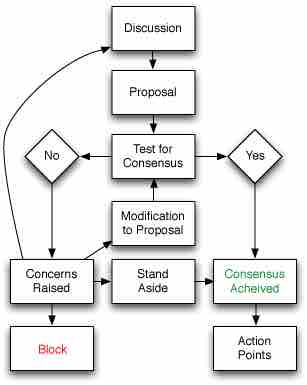Consensus decision making aims to reach agreement through collaboration, cooperation, inclusivity, and participation. Group decisions made by consensus seek resolutions that are satisfactory to all group members and meet all of their concerns. Consensus decision making is not adversarial or competitive, but rather seeks to do what is best for the group. Group members treat each other equally and solicit the input of all participants.
Making decisions by consensus is not necessarily ideal or even desirable. In an effort to please everyone, the decision may satisfy the least common denominator but not produce the best outcomes. Developing a consensus can be time consuming, and is thus more difficult to achieve when there is urgency, significant time constraints, or resource limitations.
Another way to think about consensus is as the absence of objections. In order to arrive at a group consensus, majority opinion holders must overcome any unwillingness of group members to accept a given choice. While group members may be willing to go along with a proposal, they do not actually need to favor it above another choice.
One approach to consensus building is the Quaker model. It provides a way to structure a decision process that emphasizes listening among group members. The Quaker model calls for members to refrain from speaking twice until after all group members have been heard from, the effect of which is to neutralize dominating personality types. Another key feature of the Quaker model is that it relies on a single person to act as the facilitator, or moderator, who makes sure the discussion flows according to an empathetic process. By articulating the emerging consensus, members can be clear on the decision as it emerges, and, since their views have been taken into account, will be likely to support it.

Consensus flow diagram
This diagram shows a process of steps through which consensus can be reached, by starting with concerns that are raised, moving to a discussion, then a proposal, and then further testing for consensus.
Another formal technique for consensus building comes from the consensus-oriented decision-making (CODM) model. It has seven key steps:
- Framing the topic
- Open discussion
- Identifying underlying concerns
- Collaborative proposal building
- Choosing a direction
- Synthesizing a final proposal
- Closure
The CODM model outlines a process of how proposals can be collaboratively built with the full participation of all stakeholders. This model lets groups be flexible enough to make decisions when they need to, while still following a format based on the primary values of consensus decision making.